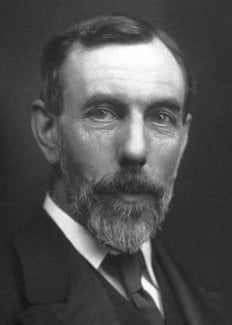Sir William Ramsay
Biographical

William Ramsay was born in Glasgow on October 2, 1852, the son of William Ramsay, C.E. and Catherine, née Robertson. He was a nephew of the geologist, Sir Andrew Ramsay.
Until 1870 he studied in his native town, following this with a period in Fittig’s laboratory at Tübingen until 1872. While there his thesis on orthotoluic acid and its derivatives earned him the degree of doctor of philosophy.
On his return to Scotland in 1872 he became assistant in chemistry at the Anderson College in Glasgow and two years later secured a similar position at the University there. In 1880 he was appointed Principal and Professor of Chemistry at University College, Bristol, and moved on in 1887 to the Chair of Inorganic Chemistry at University College, London, a post which he held until his retirement in 1913.
Ramsay’s earliest works were in the field of organic chemistry. Besides his doctor’s dissertation, about this period he published work on picoline and, in conjunction with Dobbie, on the decomposition products of the quinine alkaloids (1878-1879). From the commencement of the eighties he was chiefly active in physical chemistry, his many contributions to this branch of chemistry being mostly on stoichiometry and thermodynamics. To these must be added his investigations carried on with Sidney Young on evaporation and dissociation (1886-1889) and his work on solutions of metals (1889).
It was however in inorganic chemistry that his most celebrated discoveries were made. As early as 1885-1890 he published several notable papers on the oxides of nitrogen and followed those up with the discovery of argon, helium, neon, krypton, and xenon. Led to the conclusion by different paths and, at first, without working together, both Lord Rayleigh and Sir William Ramsay succeeded in proving that there must exist a previously unknown gas in the atmosphere. They subsequently worked in their separate laboratories on this problem but communicated the results of their labours almost daily. At the meeting of the British Association in August 1894, they announced the discovery of argon.
While seeking sources of argon in the mineral kingdom, Ramsay discovered helium in 1895. Guided by theoretical considerations founded on Mendeleev’s periodic system, he then methodically sought the missing links in the new group of elements and found neon, krypton, and xenon (1898).
Yet another discovery of Ramsay (in conjunction with Soddy), the importance of which it was impossible to foresee, was the detection of helium in the emanations of radium (1903).
With regard to the scientific honours which – besides the Nobel Prize have been awarded to Ramsay, mention can be made of a great number of honorary memberships, viz. of the Institut de France, the Royal Academies of Ireland, Berlin, Bohemia, The Netherlands, Rome, Petrograd, Turin, Roumania, Vienna, Norway and Sweden; the Academies of Geneva, Frankfurt and Mexico; the German Chemical Society; the Royal Medical and Chirurgical Society of London; the Académie de Médecine de Paris; the Pharmaceutical Society, and the Philosophical Societies of Manchester, Philadelphia and Rotterdam. He also received the Davy and Longstaff Medals, honorary doctorate of Dublin University, the Barnardo Medal and a prize of $ 5,000 from the Smithsonian Institution, a prize of Fr. 25,000 from France (together with Moissan), and the A.W. Hoffmann Medal in gold (Berlin, 1903). He was created K.C.B.(Knight Commander of the Order of Bath) in 1902, and was also a Knight of the Prussian order “Pour le mérite”, Commander of the Crown of Italy, and Officer of the Legion d’Honneur of France.
In 1881 Ramsay married Margaret, the daughter of George Stevenson Buchanan. They had one son and one daughter. His recreations were languages and travelling.
Sir William Ramsay died at High Wycombe, Buckinghamshire, on July 23, 1916.
This autobiography/biography was written at the time of the award and first published in the book series Les Prix Nobel. It was later edited and republished in Nobel Lectures. To cite this document, always state the source as shown above.
The Nobel Foundation's copyright has expired.Nobel Prizes and laureates
Six prizes were awarded for achievements that have conferred the greatest benefit to humankind. The 14 laureates' work and discoveries range from quantum tunnelling to promoting democratic rights.
See them all presented here.
